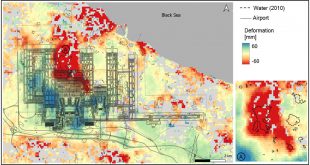Fresenius Environmental Bulletin, 28(2), 546-551
The use of broadband vegetation indices in cultivated land detection with Landsat 8 OLI multi-temporal images
Alganci, U.
Abstract: Determination of cotton and maize cultivated areas with multi-temporal satellite images using vegetation indices is the main objective of this research. Study area was located on Sanliurfa province, Turkey, which hosts huge amount of agricultural production of cotton and maize in spring-summer season with its suitable and effective irrigation system. The Landsat 8 OLI multi-temporal images acquired with 16-day interval were used to identify cultivated areas in the study area. Image acquisition dates from 30 April 2015 to 21 September 2015 completely covers the phenological development period of cultivated crop types. Terrain corrected images were radiometrically calibrated to produce Top of Atmosphere (ToA) reflectance images, in order to reduce the atmospheric and illumination effects, thus providing efficient multi-temporal analysis. ToA reflectance images were then used in vegetation index (VI) production. Normalized Difference Vegetation Index (NDVI), Transformed Difference Vegetation Index (TDVI), Enhanced Vegetation Index (EVI) and Green Normalized Difference Vegetation Index (GNDVI) were used in this research as vegetation suppression and data dimension reduction methods. Then VI image stacks were classified with pixel based Support Vector Machine (SVM) algorithm and results were compared with statistical production database to evaluate the effectiveness of broadband VIs in cultivated area and crop pattern detection. Results of the analysis provided that, GNDVI based dataset provided highest accuracies according to areal comparison and point based accuracy assessment. NDVI and TDVI based datasets were ranked as the second with similar accuracy results, while EVI based dataset was in the last place when compared to remaining VI datasets. Additionally, area determination efficiency and classification accuracy for the cotton was higher than the maize nearly in all regions.

 CSCRS İTÜ – Center for Satellite Communications and Remote Sensing
CSCRS İTÜ – Center for Satellite Communications and Remote Sensing 